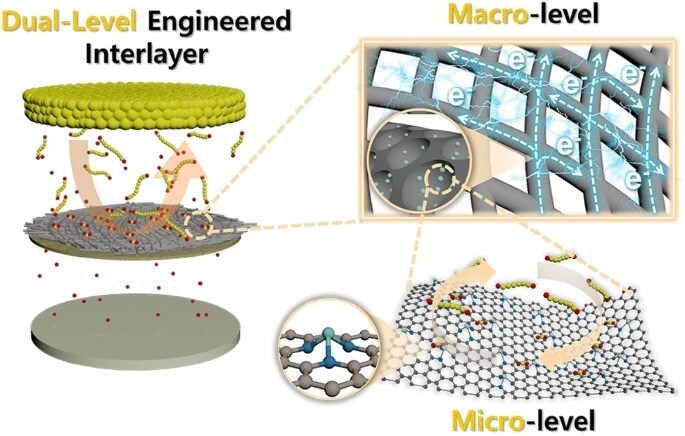Business
Researchers at Chung-Ang University Innovate Lithium-Sulfur Battery Material

A team of researchers at Chung-Ang University in Seoul, South Korea, has made significant strides in the development of interlayer materials for lithium-sulfur batteries. Their innovative approach promises to enhance battery performance and safety, potentially accelerating the transition to clean energy. The findings, published in the journal Advanced Fiber Materials on September 24, 2025, highlight the benefits of dual-level engineering in optimizing battery technology.
The research, led by Associate Professors Seung-Keun Park from the Department of Advanced Materials Engineering and Inho Nam from the Department of Chemical Engineering, focuses on utilizing carbon-supported single-atom catalysts with metal-N moieties. These catalysts are instrumental in improving redox kinetics and mitigating the dissolution of lithium polysulfides, a common issue that hampers the efficacy of lithium-sulfur batteries.
Dr. Park expressed the team’s motivation, stating, “Our motivation lies in addressing the fundamental materials challenges that have limited the development of next-generation energy storage systems.” He noted that while lithium-ion batteries have achieved widespread adoption, they are nearing their inherent energy density limits. In contrast, lithium-sulfur batteries offer a much higher theoretical capacity but face challenges like the polysulfide shuttle effect and rapid capacity fading.
To tackle these issues, the researchers embedded single cobalt atoms in a low-coordinated N3 environment within a porous carbon nanofiber network. This strategic design enhances the adsorption of lithium polysulfides and speeds up their redox reactions, effectively reducing the shuttle effect and improving overall battery kinetics.
Innovative Engineering for Enhanced Performance
The study showcases a novel dual-level engineering strategy that combines hierarchical porous carbon nanofibers with atomically dispersed cobalt single-atom sites in a low-coordinated N3 configuration. The carbon nanofiber structure provides mechanical stability and excellent electrolyte wettability, while the cobalt sites facilitate the adsorption and conversion of polysulfides.
This synergistic approach allows the battery to achieve remarkable capacity retention and performance over hundreds of cycles. Dr. Nam highlighted the practical implications of their work, stating, “Our material is free standing, binder free, and flexible. It can be directly applied as an interlayer in pouch cells and has been demonstrated to maintain mechanical integrity even under bending, while powering small devices.”
The implications of this research extend beyond laboratory settings. The advancements in battery technology could lead to the development of electric vehicles with extended driving ranges, large-scale renewable energy storage systems that effectively balance intermittent solar and wind power, and lightweight, flexible power sources for portable electronics.
Impact on Clean Energy Transition
As the world moves towards sustainable energy solutions, the development of safer and more efficient batteries is critical. The innovations from Chung-Ang University could play a pivotal role in reducing dependence on essential raw materials, lowering costs, and decreasing carbon emissions. This progress may ultimately make sustainable technologies more reliable and accessible in everyday life.
The work of Dr. Park, Dr. Nam, and their team underscores the importance of rational materials design at both the macro and atomic levels. Their findings not only address longstanding challenges in energy storage but also pave the way for high-performance lithium-sulfur batteries that can meet the demands of various real-life applications.
For further details, the original paper can be accessed through the DOI link: https://doi.org/10.1007/s42765-025-00614-w.
This research represents a promising step forward in battery technology, contributing to the broader goal of advancing clean energy solutions globally.
-

 Lifestyle5 months ago
Lifestyle5 months agoLibraries Challenge Rising E-Book Costs Amid Growing Demand
-

 Sports4 months ago
Sports4 months agoTyreek Hill Responds to Tua Tagovailoa’s Comments on Team Dynamics
-

 Sports4 months ago
Sports4 months agoLiverpool Secures Agreement to Sign Young Striker Will Wright
-

 Lifestyle4 months ago
Lifestyle4 months agoSave Your Split Tomatoes: Expert Tips for Gardeners
-

 Lifestyle4 months ago
Lifestyle4 months agoPrincess Beatrice’s Daughter Athena Joins Siblings at London Parade
-

 Science4 months ago
Science4 months agoSan Francisco Hosts Unique Contest to Identify “Performative Males”
-

 World4 months ago
World4 months agoWinter Storms Lash New South Wales with Snow, Flood Risks
-

 Science5 months ago
Science5 months agoTrump Administration Moves to Repeal Key Climate Regulation
-

 Business5 months ago
Business5 months agoSoFi Technologies Shares Slip 2% Following Insider Stock Sale
-

 Science5 months ago
Science5 months agoNew Tool Reveals Link Between Horse Coat Condition and Parasites
-

 Sports4 months ago
Sports4 months agoElon Musk Sculpture Travels From Utah to Yosemite National Park
-

 Science5 months ago
Science5 months agoNew Study Confirms Humans Transported Stonehenge Bluestones









